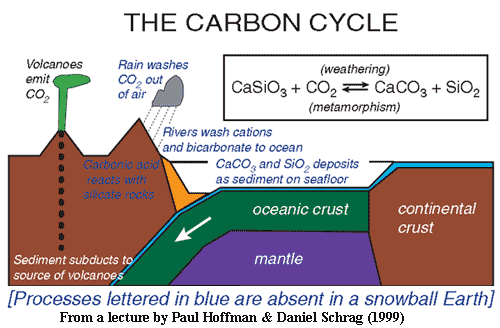| Palæos |  |
The Neoproterozoic ERA |
| THE PROTEROZOIC | Neoproterozoic |
| Page Back |
References |
|||
| Page Next | Down: Cryogenian |
| Palæos |  |
The Neoproterozoic ERA |
| THE PROTEROZOIC | Neoproterozoic |
| Page Back |
References |
|||
| Page Next | Down: Cryogenian |
|
Proterozoic
Paleoproterozoic Mesoproterozoic Neoproterozoic Tonian Cryogenian Ediacaran Phanerozoic Paleozoic |
Introduction
|
 This is
mostly a placeholder page at present. However,
there is considerable specific coverage of the Cryogenian
and Ediacaran Periods of the
Neoproterozoic.
This is
mostly a placeholder page at present. However,
there is considerable specific coverage of the Cryogenian
and Ediacaran Periods of the
Neoproterozoic.
The Neoproterozoic is a vast stretch of time which science is just beginning to explore. It begins about the time that, according to the more conservative workers, eukaryotic cells were beginning to be a significant factor (some think that the Eukarya are at least twice as old). It ends, 458 million years later, at a time when animal life was beginning to become a major factor. It is comprised of three periods: the Tonian (1000-850 My), the Cryogenian (850 to ~630 My), and the Ediacaran (~630 to 542 My). Most of the evolutionary information we can currently access comes from the last 60 million years or so of the Neoproterozoic -- roughly the last two thirds of the Ediacaran, the last period of the Era. But this envelope is being pushed quite hard at present. It wouldn't be at all surprising if, ten years from now, we will be have pushed this curtain back to the Mesoproterozoic.
As usual, the geologists are leading the charge. Once
they have sketched the outlines of the basic chronology, geochemistry and
geography, the rest will probably fall, microfossil by microfossil.
Currently, the front line is Snowball Earth, and we will have much to say on
that topic. What seems certain is that there were between two and four
intense ice ages during the Cryogenian and into the Early Ediacaran. The
hot topic is just how cold did it get? How long did they last, and how did
they end? What, if anything, is the relationship with the evolution of
animals, which seem to first appear just after the last of the ice was
retreating? Beyond the Cryogenian, advance elements are already  beginning
to take on the break-up of the supercontinent of Rodinia during the Tonian, an
event which may have been at least as dramatic as the Ice Ages of the
Cryogenian, and is even less well understood.
beginning
to take on the break-up of the supercontinent of Rodinia during the Tonian, an
event which may have been at least as dramatic as the Ice Ages of the
Cryogenian, and is even less well understood.
Looming over the whole era is another, more diffuse, campaign to establish beachheads in geochemistry. We have remarkably little knowledge of the levels of oxygen and carbon dioxide during the Neoproterozoic, or of how the various chemical cycles worked. Yet without a handle on these parameters, it's hard to evaluate the competing theories about the ice ages of the Cryogenian, or say much about the environment in which the first metazoans evolved. We will run into a few of these brick walls in our discussions of the Snowball Earth. The carbon cycle is particularly critical, but has also proved particularly hard to pin down. Other important questions turn on worldwide budgets for magnesium, sulfur, and iron.
Despite these obstacles, the geologists are making progress; and, as mentioned, the last 50 My or so of the era are now open to the evolutionary biologists and paleontologists. Twenty years ago, we had only a few fossil forms from Australia and Russia. Now, various different Ediacaran communities are being explored in at least a dozen locations. At the moment, it's still hard to see any pattern in the data, but at least we're seeing lots of data. It seems likely that our lineage, the Bilateria, evolved quite early on. However, the ecosystems of the Ediacaran Period were dominated by large forms which are hard to identify. Many will probably turn out to be Cnidarians. Surprisingly few are likely to be Porifera. Many may not be metazoans at all, but a competing lineage of Fungi that became extinct in the Early Cambrian.
All things considered, the Neoproterozoic is likely to be the most exciting region of spacetime to be involved with over the next decade or two.
ATW059017.
Images: the images of Rodinia are from, respectively, (left) somewhere deep in the heart of the University of Texas computer system, and (right) an on-line paper by Toni Eerola (heading in Finnish, but paper mostly in Portuguese and English) titled Fluxos de lama, erupções vulcânicas e/ou glaciação há 600 milhões de anos em Lavras do Sul, RS? Pesquisas geológicas no Sul do Brasil.
| Page Back | Unit Home | Page Top | Page Next |
images not loading? | error messages? | broken links? | suggestions? | criticism?
augwhite@sbcglobal.net
page uploaded ATW050917
checked ATW060221